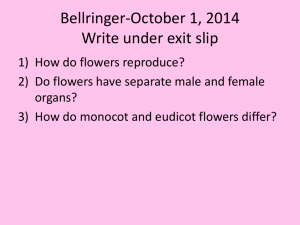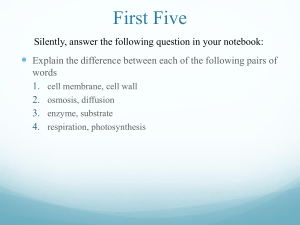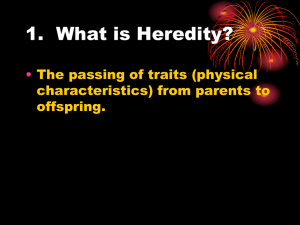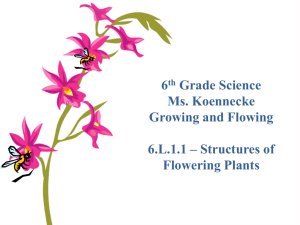Topic: Reproduction
advertisement
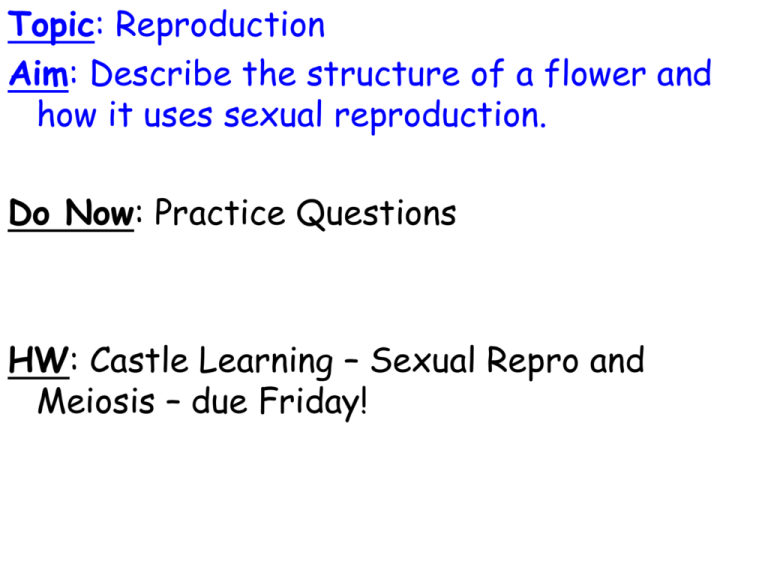
Topic: Reproduction Aim: Describe the structure of a flower and how it uses sexual reproduction. Do Now: Practice Questions HW: Castle Learning – Sexual Repro and Meiosis – due Friday! 1. What is structure A? How was it produced? •zygote •fertilization 2. Which structures represent cleavage? B, C, D 3. What is structure E? blastula 4. What is structure F? gastrula 1.Identify all the structures that are labeled. G - ovary H - oviduct I - uterus J – urinary bladder K - vagina 1. Where does fertilization occur? H - oviduct 2.Where does the embryo develop? I - uterus 3.Where does the placenta develop? I - uterus Stamen • Male reproductive organ • Anther: produces pollen grains (male gametes) • Filament: stalklike structure Pistil • Female reproductive organ • Stigma: receives pollen (sticky) • Style: supports stigma • Ovary: contains ovules (contain eggs) – Once eggs are fertilized: • Ovary will develop into fruit • Ovules become seeds Petals • Attract pollinators: –bright colored –perfume –nectar Pollination • Transfer of pollen from anther to stigma • Cross pollination: pollen from one flower sticks to the sigma of a DIFFERENT flower • Self pollination: pollen sticks to the stigma of SAME flower Cross pollination or self pollination? How does • Wind, insects, pollination birds occur? What happens after pollination occurs? http://www.youtube.com/watch?v=bwCpQflmQG4&feature=related Pollen tube Ovules • Pollen tube grows down style and into ovule • Pollen moves down pollen tube • Egg is fertilized zygote develops into embryo • Ovule develops into seed • Ovary develops into a fruit http://www.youtube.com/watch?v=KMQtLWpAdXI&feature=related Seed Structure Seed coat 1.Embryo: - Epicotyl: will develop into the upper portion of the plant - Hypocotyl: will develop into roots and lower portion of the plant Epicotyl Hypocotyl 2.Cotyledon: food source for plant embryo Cotyledon Let’s summarize… 1. Describe the male reproductive organ of the flower. 2. Describe the female reproductive organ of the flower. 3. Explain what occurs during pollination. 4. Explain what occurs after pollination. 5. Explain what happens to the flower once the eggs are fertilized. 6. Describe the structure of a seed. 1. The part of the pistil which contains the pollen tube is the __________. 2. The transfer of pollen between the anther and the stigma in any flowering plant or plants is called _____. 3. ________ pollination occurs when pollen is transferred between flowers on different plants. 4. In order to reach an ovule, a ______ must grow through the style. 1. The sex cells in a flowering plant are located in the (1) sepals and petals (2) stigma and nectar (3) fruit and seed (4) stamens and pistil 2. In order to reach an ovule, a ___________ grows through the style and into the ovary. (1) sepal (2) fruit (3) pollen tube (4) seed 3. The egg cell of a flowering plant develops in the (1) pollen grain (2) ovule (3) Stigma (4) fruit 1. The sperm of flowering plants is contained in the ______ grain. 2. The entire female reproductive organ in flowering plants is called the _______. 3. The sticky top of the pistil is called the _______. 4. The entire male reproductive organ in flowering plants is called the ________. pistil stamen 7 3 anther 1 filament 2 4stigma 5 style 6 ovary stamen 3 anther 1 filament 2 petal 8 4stigma pistil 5 style 6 ovary 9 sepal 7

